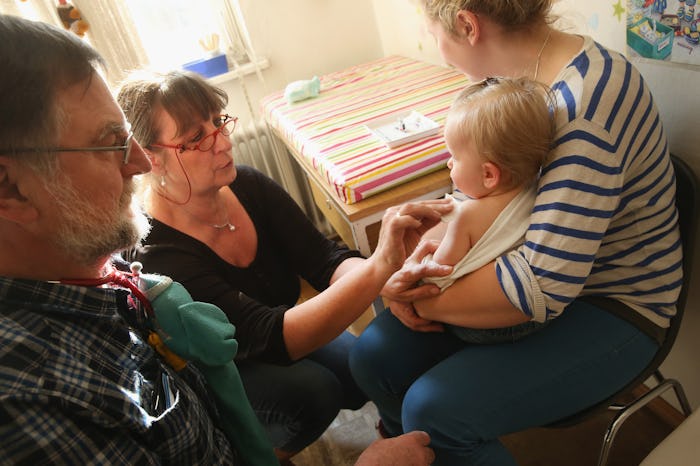Life

6 Signs Of The Measles Every Parent Should Be Aware Of
The measles is an extremely contagious viral disease that affects mostly children, although adults can certainly get it, too. And since more parents are deciding to forego measles vaccines — and, as a result, there are at least 107 confirmed cases of measles across 22 states — it's more important than ever before that parents are aware of the signs of the measles, so they know what to look out for when caring for their own children.
According to Kid's Health, the measles is a contagious respiratory infection that causes flu-like symptoms and a body rash. Before the measles vaccine was made avialble to U.S. citizens, more than 500,000 cases were reported and 500 people died. Since the vaccine, however, measles has become incredibly rare in the U.S., which is why it's so upsetting that some parents are choosing to forego the vaccine and the number of reported measles cases in the country is steadily increasing.
According to the National Organization of Rare Diseases (NORD), it's "often difficult to avoid exposure to measles because it can be contracted from someone whose symptoms have not yet appeared." In other words, you could contract the disease from someone who isn't showing any signs of being sick. That's why it's so important to vaccinate your children, first and foremost, and be on the lookout for early signs and symptoms of the disease so you can help your child receive the care they need as soon as possible.
High Fever
According to Kid's Health, a high fever is one of the first signs your child has the measles. Sometimes that fever can be as high as 104°F, which is why you should call your doctor immediately if your child has a high fever and you know they've been around someone who has the measles, especially if they're an infant, are on medications that impair the immune system, or suffer from tuberculosis, cancer, or a disease that affects the immune system.
A Hacking Cough
According to the Centers for Disease Control and Prevention (CDC), a hacking cough is another symptom of measles, and will usually occur seven to 14 days after a person has been infected with the disease.
Runny Nose
A runny nose can be caused by a variety of things, from a common cold to allergies to, yes, the measles. According to the CDC, it's important to look at a runny nose, a high fever, and a cough collectively. If your child has all of these symptoms at once, it's time to call the doctor.
Red, Watery Eyes
Red, itchy, watery eyes — also known as conjunctivitis — is another early symptom of the measles, according to the CDC> If the lining of your child's eyes are inflamed, make sure you take them to the doctor so their physician can not only rule out the measles, but any other form of contagious conjunctivitis (like pink eye).
Tiny White Spots Inside Your Child's Mouth
If your child has the measles, you will notice Koplik's spots — small, red spots with blue-white centers — inside their mouth and long before they develop a skin rash. According to NORD, these spots often go unnoticed and form opposite the molars about two days after the first onset of early measles symptoms.
A Skin Rash
According to NORD, "a telltale rash appears first on the face and neck, then on the trunk, arms and legs" four days after the first symptoms of the measles occur. The rash is red and/or reddish brown in color, and, according to the Mayo Clinic, are "large, flat blotches that often flow into one another."
There may be a sensitivity to light and/or listlessness that accompanies the rash, but the virus should run its entire course around 10 days. There's no measles-specific treatment, which, again, is why you should vaccinate your children. According to the Mayo Clinic, complications can occur as a result of contracting the measles, including an ear infection, bronchitis, laryngitis, croup, pneumonia, encephalitis, and, if you're pregnant, preterm labor, low birth weight, and maternal death.